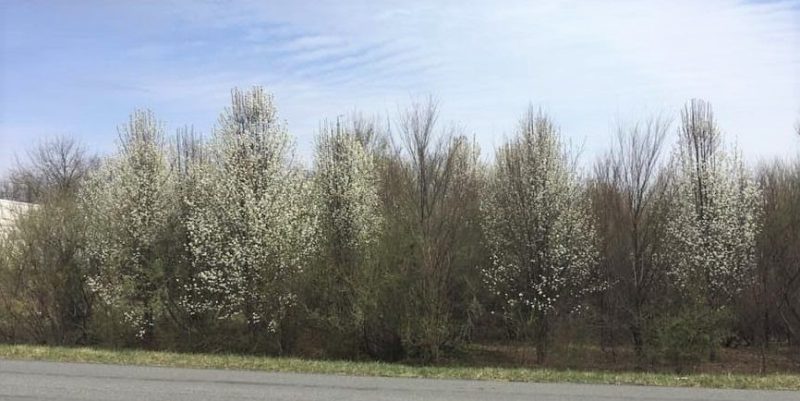
April 5, 2021 — There is no doubt the wild landscape in the New River Valley is a beautiful sight to behold, largely because of the springtime blanket of white blossoms from wild Callery pear trees.
But while those early-blooming trees might look beautiful from a car window, Callery pear trees pose a real threat to urban and suburban environments, home landscapes, and wild areas. So says Eric Wiseman, an associate professor of forestry and arboriculture at Virginia Tech and a Virginia Cooperative Extension specialist in the College of Natural Resources and Environment.
As Wiseman tells the story, popular cultivars of the Callery pear, such as the ‘Bradford’ pear, have been widely used as ornamental landscape trees since the 1970s. While Bradford pears were initially seen as cost-effective, fast-growing, and easy-to-establish additions to the suburban landscape, their structural weakness as mature trees and the ease with which their seedlings spread present several problems.
“Bradford pears are beautiful as young trees, but as they mature, you will eventually experience losses when you install them in your landscape,” says Wiseman. “The Bradford cultivar of Callery pear is particularly susceptible to branch and stem failure due to bark inclusion.
“The trees grow very fast and tend to have very upright branches growing close together. Often, these branches will grow into one another, trapping bark in between them, which creates an ‘inclusion’ that causes friction and can cause the tree to split, potentially causing damage to the landscape or nearby structures,” Wiseman said.
Callery pears also pose serious environmental concerns.
Ornamental plantings of Bradford pear often produce fertile seeds that are readily spread by birds. These wild-growing seedlings inherit the genetics of their uncultivated ancestors, which means they can develop undesirable characteristics, notably sharp thorns, that are not seen in cultivated varieties of Callery pear. Since Callery pear trees are tolerant of harsh growing conditions and thrive even in poor soil, these seedlings establish easily in disturbed areas, such as roadsides.
“In areas without active vegetation control, such as roadsides and road interchanges, you see a proliferation of Callery pear. There are some areas along roads that are now 100 percent Callery pear trees,” Wiseman said.
“They’re also very hard to control. If you cut the stem back at ground level, it will still grow from the root, so all you’ve done is cut the plant back, not kill it,” he added.
“In the Northern Shenandoah Valley, we have seen Callery pear overtake fallow fields,” said Mark Sutphin, Virginia Cooperative Extension agent in Frederick County. “Then when people go to reclaim their field, they have a really difficult time. The seedlings can have significant thorns, almost like a honey locust, that makes them very hard to remove. The thorns will even pop tires.
“Though places in Northern Virginia have been dealing with this issue for a long time, it’s only within the last 10 years that we’ve started to see Callery pear become a real problem in the Northern Shenandoah Valley,” he said.
The Callery pear’s spread throughout the commonwealth also means a shrinking biodiversity of Virginia’s urban forests.
“More resilient forests are less susceptible to problems with disease and insect pests we’ve seen in the last decades,” Wiseman said. “The Callery pear is not a good tree to have in the urban environment.”
There are ornamental alternatives to invasive Bradford and Callery pear cultivars that homeowners can plant and cultivate.
Wiseman emphasizes that “nonnative” does not necessarily mean “invasive,” and some “nonnative” tree species make fine replacements, though he does recommend planting native species when possible.
A few native alternatives to Bradford or other Callery pear cultivars Wiseman suggests are flowering dogwood, serviceberry, green hawthorn, chokecherry, and white fringe trees.
A few nonative alternatives to Bradford or other Callery pear cultivars that Wiseman suggests are the Japanese tree lilac, crepe-myrtle, tatarian maple,, amur maackia, and the Adirondack crabapple.


